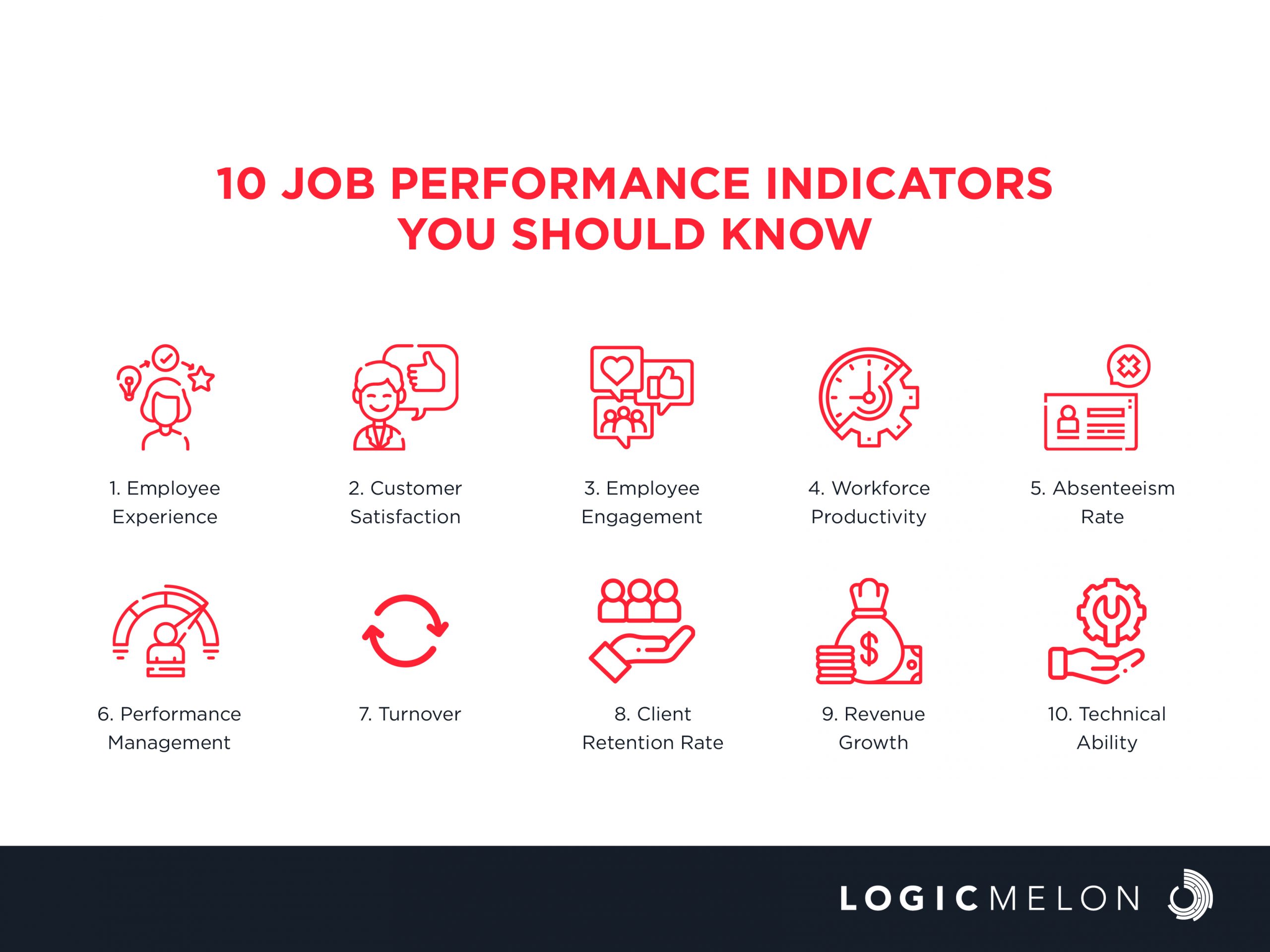10 Job Performance Indicator You Should Know
Measuring the value that determines how effectively the team or the organisation has to achieve it’s objective is the Job Performance Indicator.
Job performance Indicator assesses whether the employee performs the job well. Performance is a crucial outcome for the growth and success of any organisation.
KPI, which stands for Key Performance Indicators, is a measurable value that demonstrates how effectively a company is achieving key business objectives. KPI examples are “targeted new customers per month.” Metrics measure the success of everyday business activities that support your KPIs. While they impact your outcomes, they are not the most critical measures.
Ways to Measure Job Performance
1. Graphic Rating Scale
The Graphic Rating Scale is a performance appraisal method in which an employee is assessed based on criteria that are considered important and relevant to both performance and productivity.
2. Self-Evaluation
Self-evaluation is the process of looking at oneself to assess aspects that are important to one’s identity. Your involvement enables you to honestly assess your strengths and also areas to improve. Tips for writing self-evaluation are:
- Be specific and provide examples.
- Back up your contributions with metrics.
- Frame weaknesses as opportunities.
- Keep track of your accomplishments throughout a period of time.
3. 360-Degree Feedback
360-degree feedback is a process in which feedback from an employee’s subordinate, colleagues, and supervisor, as well as a self-evaluation by the employee, is gathered.
4. Management by Objectives
MBO (Management by Objectives) is a process in which a manager and an employee agree on specific performance goals and then develop a plan to reach them.
5. A Checklist
A checklist is a type of job performance to reduce the failure of missing out on tasks. It helps to ensure consistency and completeness in carrying out tasks.
How Do You Rank Employees?
1. Observe
Observe your employees performance constantly and jot down notable incidents in their workdays whether it is good or bad. It is quite easy to remember the bad things and you might forget to mention and give credit to the good things that happen. So, get into a habit of maintaining all the notable instances.
2. Maintain the Evaluation Sheet
Maintain the evaluation sheet, and read the notes thoroughly before making decisions about how to mark the evaluation sheet for each employee.
3. Meeting with Employees
Meet your employees to discuss your findings after ranking their skills and potential. Be prepared for an open-minded discussion about the ways that both your employees and the organisation can improve in the future.
4. Feedback
Ask for feedback on the ranking system you have maintained, your employees might have gotten valuable feedback that you may not have considered.
The Benefits of Job Performance Indicator
1. Effective and Efficient
The KPI helps people quickly understand complex statutes that are efficient, and helps to identify the areas that improve the productivity of employees by taking corrective action, which is effective for organisation success.
2. Decision-Making
The job performance indicator helps in decision-making and can help minimize bias. Organisations use a job performance indicator, which ascertains the areas they improve, and time management to better plan and execute decisions for the growth of employee performance and the organisation.
3. Direction
A job performance indicator shows the direction the company is working towards according to the company’s performance.
4. Consistency
The job performance indicators lead the way for the quality of always having the same standard, opinions, and behaviour.
5. Productivity
Productivity is the measure of economic performance that compares the amount of output produced with the number of inputs.
Employee Performance Metrics
Employee performance metrics are a form of workforce analytics used to track how well employees are performing.
1. Work Efficiency
Employees need to be able to prioritize things to get them done as efficiently as possible. Employees should be able to gauge how efficiently a job was executed.
2. Quality of Work
The quality of an employee’s work should sync with the company’s expectations. Employees whose work quality is poor can cause frustration to both the customers and coworkers.
When employees struggle with meeting performance goals because their work quality is not meeting the standards, it is can be corrected, and they can easily achieve their goals.
3. Teamwork
It is important to foster a culture of teamwork, and help the team perform better when approaching a complex problem and solving it as a group.
Teamwork is not a quantitative metric, but there are ways to track it. For example, HR can use Pulse surveys. This measures the impacts of events irrespective of the size. Managers can keep track within their project management with the question, “who would you like to thank for going the extra mile?”
4. Learning Ability
An organisation and its employees’ ability to become or remain relevant comes down to their ability to learn and adapt. To make this happen, the training program must be designed to meet the specific needs of the employees.
5. Time Management
Adhering to timelines is a key performance metric across all functions that have tasks whose deliveries are completely dependent on the employees.
10 Job Performance Indicator You Should Know

1. Employee Experience
The Employee Experience in an organisation is the usage of relevant skills that indicate the productivity of doing work. It is the result of all interactions an employee has with their employer.
2. Customer Satisfaction
Customer satisfaction is defined as a measurement that determines how the product, services, and business capabilities satisfy the customer. Customer satisfaction information, including surveys and ratings, can help the company to best determine how to best improve performance or change its product or services to the customers.
3. Employee Engagement
The amount of employee engagement helps the organisation understand the participation level of the employees, and can educate the employee how to engage more in company discussions.
4. Workforce Productivity
Workforce Productivity shows whether the targets are met or not within a certain timeframe. This is a clear indicator of job performance in the workplace.
5. Absenteeism Rate
The Absenteeism Rate helps reveal the employee working days and productivity hours in the organisation. This can help to decide how to compensate for work from those non-working hours.
6. Performance Management
Performance Management is the process of ensuring that the set of activities and outputs meet the organisation’s goals in an effective and efficient manner. It can focus on the performance of an organisation, a department, an employee, or the processes in place to manage particular tasks.
7. Turnover
While calculating the turnover for the organisation it shows the results from the efforts of employees and whether to improve performance management. The organisation can have a lasting impact on a business’s success. It is just as important as other key financial and customer-related metrics.
8. Client Retention Rate
The customer retention rate is the percentage of existing customers who remain customers even after a given time. The client retention rate helps to discover the efforts made by the employee to provide the best performance to their existing clients.
9. Revenue Growth
Revenue growth shows the growth of the organisation used to measure how sales increase or decrease over time. The amount of money your company makes over a pre-determined time compared to a previous, identical amount of time. In other words, it is how much money you made this month compared to last month.
10. Technical Ability
Technical Ability shows the employee’s skills that determine the specific business outcomes they can help you work more efficiently, boost your confidence, and make you a valuable candidate for employers. Candidates who have technical skills are often more confident when applying to certain industries than those who don’t.
Frequently Asked Questions (FAQs)
1. How do you measure job performance?
The ways to measure job performance are by graphic rating scales, 360-degree feedback, self-evaluation, management by objectives (MBO), and checklists.
2. What is KPI?
KPI stands for Key Performance Indicators, which means evaluating the success of an organisation, or of a particular activity in which it engages.
3. How do you introduce KPI to employees?
First, identify the area of business performance you want to measure, establish the target against the performance you wish to measure, Compare current performance with the defined target, and review the performance changes to date.
4. How does a job performance indicator help increase efficiency in communication?
Communication takes time, particularly in complex and unpredictable situations. It is key to ensuring quick adaptation to new circumstances. A job performance indicator helps to boost communication when groups share understanding, and vision on how to achieve certain tasks, agreeing on a job performance indicator can help increase productivity, morale, and output through teamwork.
Closing Thoughts
Job performance indicators are essential tools for measuring employee productivity. The ways to measure job performance are by the graphic scale method, 360-degree feedback, self-evaluation, management by objectives, and checklists. The benefits of a job performance indicator are it is effective and efficient, helps with decision-making, and is consistent, directive, and productive.
The performance indicators are employee experience, customer satisfaction, employee engagement, workforce productivity, absenteeism rate, performance management, turnover, client retention rate, revenue growth, and technical ability.
LogicMelon
Award-winning recruitment software that will find, attract, hire and analyse the way you want to work. At LogicMelon, we have experienced software recruitment marketing specialists to help you build effective recruitment solutions supported by the best customer service you’ll find anywhere!
Email: sales@logicmelon.com or call LogicMelon (UK) +44 (0) 203 553 3667 (USA) +1 860 269 3089
How to Give the Best Interview Feedback
By providing valuable interview feedback, you can help another person learn from their experience and grow as a professional.
HR KPI: Top Key Performance Indicators for Human Resources
Establishing HR KPIs is key to unlocking the full potential of your company’s human capital. Read the blog to know more.
Winning with your Talent Management Strategy
In this blog, we’ll explore the importance of talent management strategy and provide practical tips to help you implement it effectively.


